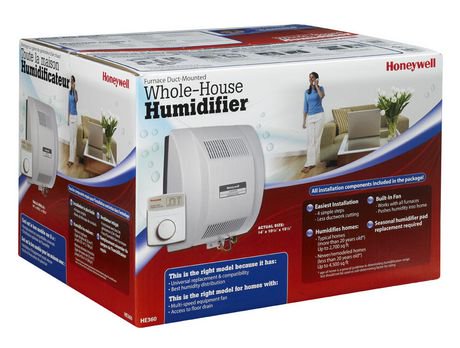Ideal indoor humidity levels should be between 30% and 50%. Unfortunately, moisture can move in and out of the home without your knowledge or control. Indoor air quality is compromised when humidity levels dip below 30% or rise above 50%. In the winter, the combination of cold, dry air outside and heated air inside can cause de-humidification. This process can be extremely harmful to both your household and your home.
Signs of Low Humidity
- Dry, Itchy Skin,
- Allergies & Asthma
- Nose Bleeds
- Dry Eyes
- Sore Throat
- Indoor Pathogens
- Cracked Wood
- Dust
- Bacteria
- Static Electricity
In the summer, however, the air gets more humid, creating its own set of problems. Too much moisture in the home can lead to mold and mildew, rotted wood, and poor indoor air quality.
Signs of High Humidity
- Musty and mildewy odors
- Moisture near doors and windows
- Mold and mildew
- Damp and stuffy rooms
- Discoloration and condensation near your HVAC system
- Warped, cracked, or damaged wood surfaces
- Sweating on pipes and duct-work
- Chipping concrete and masonry
If you don’t already have a built-in humidification system for your home, consider purchasing an inexpensive hygrometer to measure your indoor humidity levels.
Sources of Moisture Problems
- Cracks and gaps in the foundation
- Gutter and drainage issues outside
- Leaking pipes
- Appliances such as washers, dishwashers, and HVAC systems
- Showers and bathtubs
- Stove-tops, sinks and dishwashers
- Plants
- Portable humidifiers
- Leaky windows and doors
- Improperly installed HVAC. plumbing, and ventilation systems
Learn how to Conquer Moisture and Humidity in Your Home.
Benefits of Whole-Home Humidification
Unlike portable humidifiers and dehumidifiers, which are designed to work in a confined area, whole-house humidification systems automatically measure humidity levels and add or take away moisture to maintain ideal humidity levels. There is no need to add or take away any water because the whole-house humidifier gets water from your existing plumbing system and releases water through your drain lines. There are two different types of whole house humidifiers that are common on the market. They both operate in a similar way, but have minor differences for different needs:
A Bypass Humidifier
This kind of design hooks onto the furnace duct-work.When the furnace blower is turned on, water is added to the filtered panel. The hot air blows through this panel, which adds water droplets to the circulated air.
A Power Humidifier
This appliance has its own blower built-in, which allows it to run whether or not the HVAC unit is on or not. More moisture is generated compared to the bypass designs, making them ideal for larger homes requiring higher humidity levels.
Safety and Convenience
Whole-home humidifiers are much safer and more convenient than portable models. Single-room units require regular maintenance to avoid the build-up of mold and bacteria. There’s no worry of a mold issue with a whole-house system because there’s no standing reservoir of water – and all the excess moisture drains away. Portable humidifiers also require distilled water to ensure they run properly. A whole-home unit uses water from your home’s plumbing system, which is much cheaper and is refilled automatically.
Benefits of Whole-Home Humidification
- Moisturizes the air and provides skin and respiratory relief
- Prevents drying and cracking furniture, art, and woodwork
- Gives you clean, comfortable air that feels great all year long
Condensation Rule
When using any humidifier always monitor your windows (regardless of the season). Adding a little moisture to the air can make the home feel warmer and more comfortable, but too much moisture can cause condensation and wood rot. If you notice condensation forming, that’s a sign that there is too much humidity in the air. Turn the humidistat down to make sure that you don’t damage the interior of your home. The excess moisture can damage paint, wood, and the window itself. In the winter, you’ll have to be very careful about the humidity levels. Even a low amount can cause condensation when it’s extremely cold outside. Some humidifiers come with an automatic control that features an outdoor sensor, which can make temperature adjustments for you.
Humidification Maintenance
While both a bypass and power humidifier require little maintenance (compared to portable models), the water panel on each needs to be changed annually. A power humidifier will also need more attention as its motor will require consistent maintenance to keep it running properly. A qualified technician can easily look over the humidifier during regularly scheduled HVAC maintenance visits. They will clean out any debris in the filter and make sure that the drain is clear. The content on these web pages is based on EPA’s A Brief Guide to Mold, Moisture and Your Home. Updates have been made to some resources and links. Learn tips and tricks for preventing mold and mildew. For perfect air, you need perfect humidity. Contact McKee Bros today for more information on whole-house humidification systems. 401-723-1100
McKee Bros Energy Solutions Plumbing, Heating, Cooling provides residential and light-commercial service and repair throughout Rhode Island & S.E Massachusetts. With our mantra, “Service Awaits Your Call!” we are dedicated to resolving any minor or major issue! You can also keep up with all of our news and updates by following us on Facebook, Twitter &Instagram. We are available 24/7 to help with any plumbing, heating & Cooling problems you may have (holidays included).




